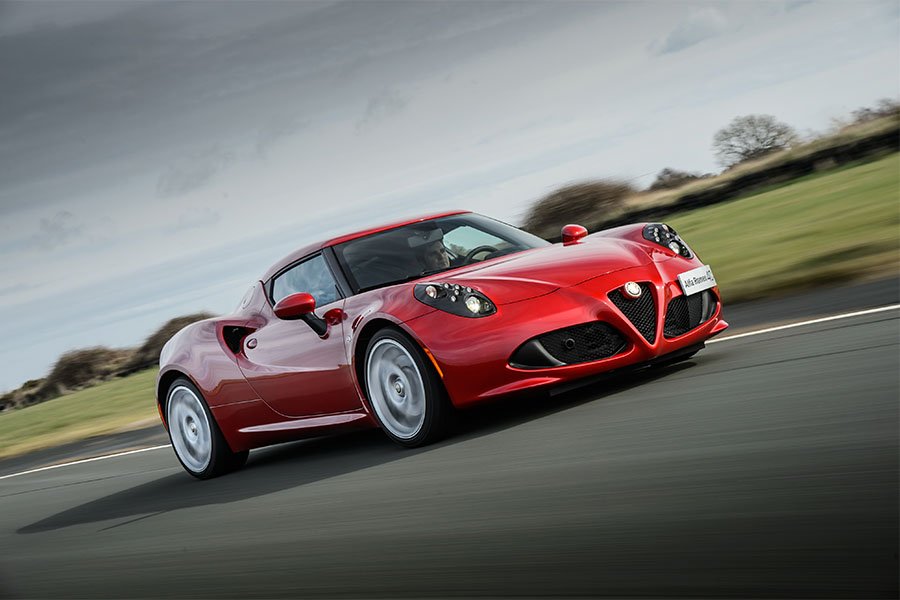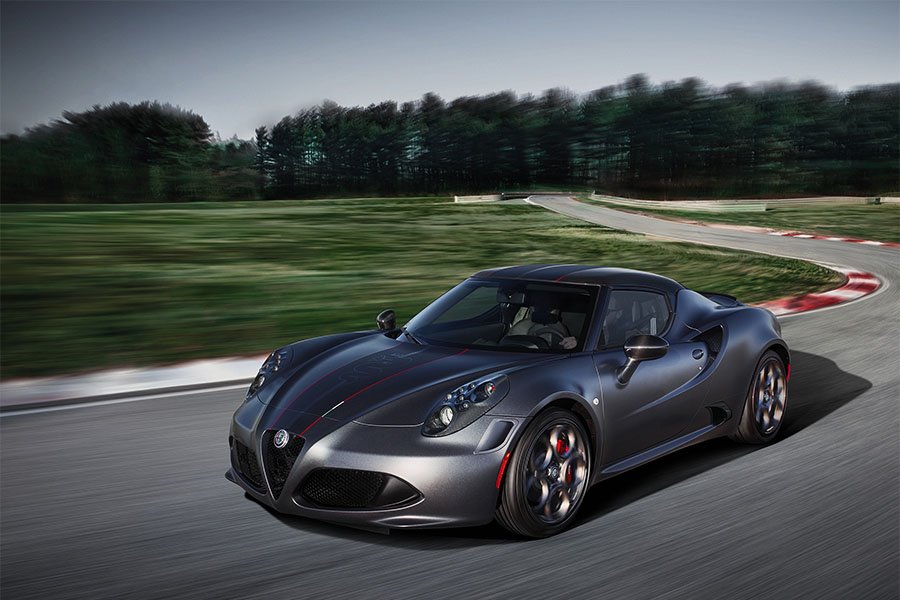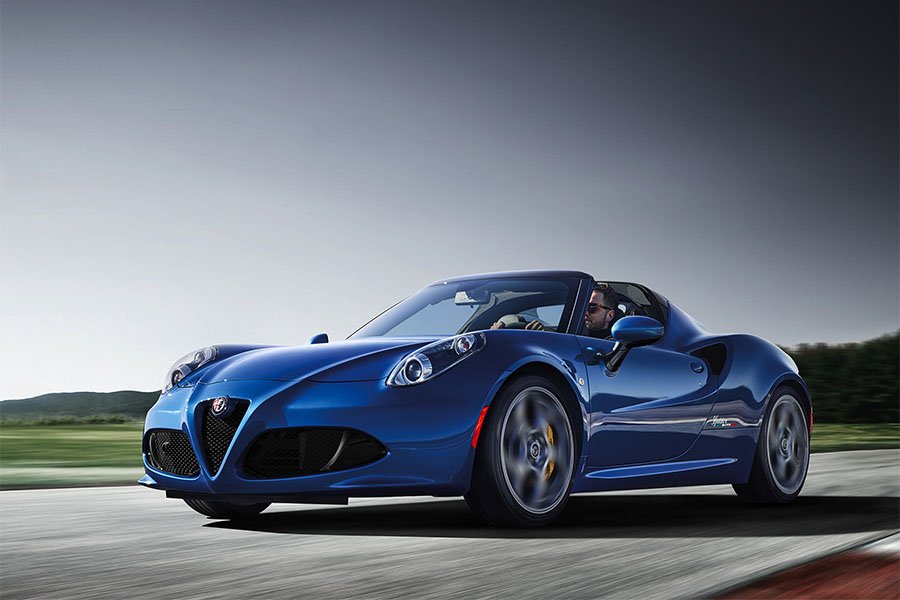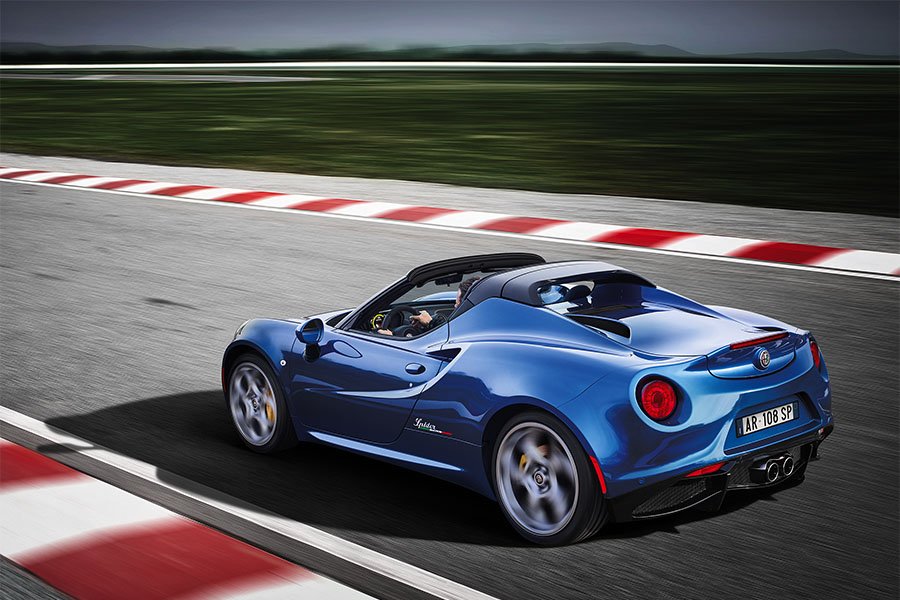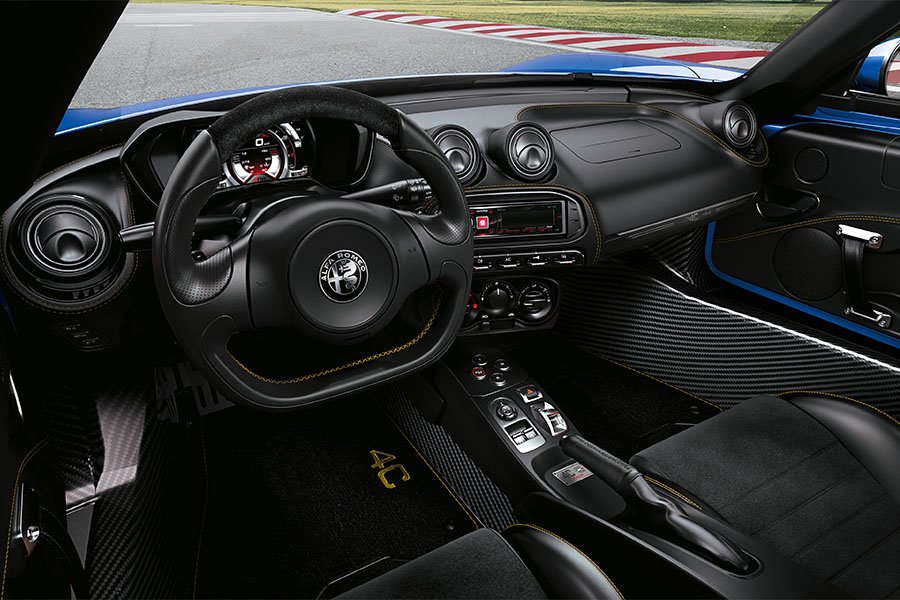Guide: Alfa Romeo 4C - a Historical & Technical Appraisal
/BACKGROUND
The beautiful but very expensive 8C manufactured between 2007 and 2010 had a transformative effect on Alfa Romeo's image. Although the company had built a couple of high performance GTA models in the early 2000s, there had been relatively little to get the blood of serious drivers pumping for quite a few years.
Despite a high price, both the fixed head 8C Competizione and subsequent 8C Spider were over-subscribed as buyers clamoured to get their hands on what became an instant classic.
The 8C also marked Alfa's return to the US market after an absence of a dozen years. Owing to a lack of established Alfa Romeo main dealers across the Atlantic, it was sold through American Maserati outlets.
Like Alfa Romeo, Maserati was owned by Fiat. Further collaboration between the parent company’s subsidiaries saw the 8C constructed at the Maserati factory in Modena. Yet more crossover from the Fiat Group resulted in the 8C running an engine and gearbox sourced from Ferrari.
Following the 8C's successful rollout, Alfa Romeo considered building a cheaper sports car that would add some further gloss to the brand and spearhead a full blown return to the North American market with a complete range of models.
Management gave the green light to the new car, dubbed Type 960, in September 2010.
The resultant Alfa Romeo 4C made its debut as a design concept six months later at the Geneva Motor Show in March 2011.
While stylistically there was an obvious family lineage between the 8C and 4C, under the skin the two cars could not have been more different. The outgoing model had featured a normally aspirated front-mounted V8 and a conventional steel bodyshell. By contract, the 4C would use a mid-mounted twin-turbocharged inline four cylinder engine and a carbonfibre tub.
Ambitiously, Alfa Romeo hoped to sell as many as 3500 examples of the new car every year.
The finished 4C made its debut at the Geneva Motor Show in March 2013. Production began two months later. As per the 8C, assembly took place at the Maserati plant in Modena.
A 4C Spider subsequently appeared in prototype trim at Geneva in March 2014. The production 4C Spider then followed at Detroit in January 2015.
CHASSIS
The 4C was based around a central carbonfibre tub developed in conjunction with Dallara Automobili in Parma. Production was handled by Tecno Tessile Adler in Airola.
No other manufacturer had ever tried to produce a carbon-tubbed car at the 4C's price point; rivals Lotus used an extruded and bonded aluminium tub for the Elise / Exige while Porsche used a conventional steel monocoque for the Boxster / Cayman.
The 4C's naked tub weighed just 65kg. Aluminium subframes were attached at either end and the roof was given aluminium reinforcement which took the fully assembled chassis up to 107kg.
The wheelbase measured 2380mm.
Suspension was via double wishbones up front and MacPherson struts out back. Coil sprung dampers were fitted all round along with a front anti-roll bar.
Ventilated Brembo brakes were installed at each corner. There were 305mm diameter discs with four-piston calipers at the front and 292mm discs with single-piston calipers at the rear.
ABS was fitted, but power steering was never offered.
The standard-issue cast alloy wheels had a five Twin Spoke design and were finished in silver. The fronts measured 7 x 17-inches and the rears were 8 x 18-inches. OEM tyres were Pirelli P Zeros.
A diminutive 40-litre fuel tank was located in the engine compartment.
ENGINE / TRANSMISSION
The 4C's transversely-mounted 1.75-litre turbocharged inline four cylinder engine was based on the Tipo 940 A 1000 unit found in the contemporary Giulietta 1750 TBi.
Most significantly, the 4C engine (Tipo 960 A 1000) incorporated a new aluminium alloy block to replace the original cast-iron unit. The result was a weight saving of 22kg.
4C engines also ran a slightly increased compression ratio (9.5:1 as opposed to 9.25:1).
The intercooled single scroll turbo (an Alfa-specific Borg Warner K04 2280 DCBCB 688) ran at up to 1.5 bar. It worked in conjunction with a pulse converter exhaust manifold that exploited pressure waves to boost torque at low engine speeds.
As per the Giulietta motor, the 4C engine incorporated dual overhead camshafts, four valves per cylinder, variable valve timing, wet-sump lubrication and direct petrol-injection.
Displacement was an unchanged 1742cc thanks to a bore and stroke of 83mm and 80.5mm respectively.
A power output of 237bhp at 6000rpm represented an incredible 136.1bhp per-litre. The torque rating was 258lb-ft between 2100rpm to 3750rpm.
For comparison, the iron-block Giulietta motor produced 232bhp at 5500rpm and 251lb-ft at 1900rpm.
Meanwhile, arguably the least impressive aspect of the 8C had been it's single clutch F1-style transmission.
By contrast, the 4C came with a six-speed TCT dual clutch transmission where the next gear was selected while the previous gear was still engaged to practically eliminate any discontinuity of power transmission.
Via a control selector on the transmission tunnel, one of four drive modes could be selected: All Weather, Natural, Dynamic or Race, each of which adjusted the behaviour of the engine, throttle response, shift time, suspension and brakes.
In Race mode, the ESC stability control and ASR traction control systems were switched off. However, Alfa’s Q2 differential control system remained active to ensure the fastest possible exit speed from corners.
A Launch Control function was also included.
BODYWORK
To create the 4C's bodywork, the designers at Alfa Romeo Centro Stile took inspiration from the Tipo 33 Stradale and 8C.
At the front, three large intakes were carved out from the nose. The one in the middle was shaped to mimic Alfa's traditional triangular grille profile.
Further up, intricate headlight assemblies were overly fussy but could thankfully be changed in favour of optional single projector Xenon units once the US-spec. version arrived in 2014.
Down each flank, huge shoulder-mounted intakes were located at the leading edge of the rear fenders.
A Fastback cabin profile swept down to a sloping tail fascia topped by a fixed rear spoiler.
Minimal overhangs, a low roof, short wheelbase and myriad intricate contours ensured the 4C looked like nothing else available at the time.
Body panels were a mix of injected polyurethane (bumpers and fenders) and SMC carbonfibre composite (pretty much everything else). The only sections left in exposed carbonfibre as standard were the A-pillars in order to give the impression of single-piece wraparound cockpit glass.
Buyers could initially specify one of six exterior colours: Black, Basalt Grey, White, Madreperla White, Rosso Alfa and Rosso Competizione.
INTERIOR
Inside, much of the 4C's most impressive feature, its carbofibre tub, was left on full display.
Inboard of the wide sills were a pair of two-way adjustable sports seats trimmed as standard in black fabric with red stitching. Each headrest was embroidered with an Alfa Romeo motif.
Directly behind the flat-bottomed leather-covered three-spoke steering wheel was a digital TFT dash. This displayed a large central tachometer surrounded by an array of additional data such as road speed, gear, fluid temperatures, fuel level, date, time and more.
The colours on the TFT display changed according to which drive mode was selected.
The list of standard equipment included electric windows, remote central locking, driver and passenger airbags, a tyre pressure monitoring system and aluminium pedals. Air-conditioning, an audio system and electric mirrors were no-cost options.
OPTIONS
Alfa Romeo offered the 4C with a long list of extras right from the off.
The standard issue cast alloy five Twin Spoke 17/18-inch wheels could be specified with a two-tone black and diamond cut finish.
Alternatively, handsome 8C-style 5-Disc forged alloy wheels with a bigger 18/19-inch diameter could be requested with either a silver or matt black finish.
Performance upgrades included a racing exhaust and racing suspension. The racing suspension comprised stiffer dampers, a thicker front anti-roll bar and a rear anti-roll bar (the latter of which was absent from the standard 4C).
Customers could enhance the exterior appearance of their car with a body coloured rear spoiler, exposed carbonfibre headlight surrounds, coloured brake calipers (in red, yellow or black instead of grey), Bi-LED headlights, satin black or chrome exterior mirror housings, a decal kit and an Italian flag motif on the rear fenders. Rear parking sensors were also available.
For the cockpit, Alfa Romeo offered full leather seats (in Black or Red) and part leather seats in Black with matching microfibre fabric centres and red stitching. The steering wheel could be configured with a black microfibre insert and red stitching too.
A red interior kit added a red leather insert to the base of the steering wheel, red upper sidewalls for the central tunnel, red door grab handles, a red handbrake grip and red handbrake boot.
Other options included an exposed carbonfibre instrument pod, cruise control, a premium Alfa audio system, an audio system with web applications plus voice recognition and hands-free telephony, heated exterior mirrors, floor mats with an embroidered 4C logo, a black leather car bag, a smokers kit, cup holders, an Alfa 4C-branded trolley case, an indoor car cover with 4C logo, a fire extinguisher and first aid kit.
Two bundle packs were offered at a discount compared to if the upgrades had been specified individually.
The Race Pack comprised of a racing exhaust, racing suspension, 18/19-inch five-hole forged alloy 5-Disc wheels, Pirelli P Zero Alfa Romeo Race tyres and the leather/microfibre steering wheel with red stitching.
The Luxury Pack included leather seats with microfibre fabric centres and exposed carbonfibre headlight surrounds.
WEIGHT / PERFORMANCE
At just 925kg, the 4C was substantially lighter than a Porsche Cayman and only a fraction heavier than a Lotus Elise S. Weight distribution was 40:60 front-to-rear.
Top speed was 160mph and 0-62mph took just 4.5 seconds.
4C LAUNCH EDITION
At the production 4C’s Geneva Motor Show debut in March 2013, Alfa Romeo announced the availability of 1000 Launch Edition cars (400 for Europe, Africa and the Middle East, 500 for North America and 100 for the rest of the world).
Each was automatically fitted with a range of normally optional equipment to include the racing exhaust, exposed carbonfibre headlight surrounds, exposed carbonfibre instrument pod, Bi-LED headlights, red brake calipers, 4C-branded floor mats and Black leather seats with microfibre centres and red stitching.
These cars were also equipped with several special parts such as a BMC air filter, a dark finish aluminium rear diffuser, a numbered plaque on the centre console plus re-calibrated shocks and a rear anti-roll bar.
Launch Edition equipment not initially available via the options list included exposed carbonfibre trim for the rear spoiler, exterior mirror housings, passenger-side dash insert and forward section of centre console. Additional inlets were cut into the bumpers just outboard of the headlights ostensibly to reduce front-end lift. The 18/19-inch 5-Disc wheels were given a special burnished dark titanium finish and contrast stitching was applied to the steering wheel, handbrake handle and door grab handles.
Initially, Alfa Romeo stated the Launch Edition was available in just two colours: Rosso Alfa and Carrera White. However, Rosso Competizione and Madreperla White were also subsequently offered.
USA VERSION
The US-spec. 4C was unveiled at the New York Motor Show in April 2014. To meet local safety regulations, aluminium bracing was added to the carbonfibre tub, single projector Xenon headlights were housed under clear covers and side airbags were fitted (which subsequently became standard in certain other markets).
Despite a 135kg weight gain, Alfa Romeo’s quoted performance figures were unchanged.
Deliveries began that summer for the 2015 model year.
2015 UPDATES & 4C SPIDER PRODUCTION
In January 2015, Alfa Romeo unveiled the production-ready 4C Spider having displayed a prototype at Geneva in March 2014.
It came with a removable canvas roof, a reinforced matt black rollover hoop (which could optionally be configured in exposed carbonfibre), new flying buttress-type sail panels and a flat engine cover.
Some of the bracing elements from the US-spec. 4C Coupe were also adopted which led to the Spider tipping the scales at 1015kg (or 1128kg for the US version).
The Spider automatically came with new 5-Triangle-spoke 17/18-inch alloy wheels (silver as standard or dark finish as an option).
Across-the-board updates applied around this time included revisions to the suspension geometry and front dampers, a new audio system and improved transmission cooling.
Several new options also came on stream.
Buyers could now specify 18/19-inch ten-spoke Spider Design wheels in silver or dark finish, a switchable centrally-exiting Akropovic titaniuam exhaust, an exposed carbonfibre intake scoop for the gearbox (located ahead of the left-hand rear wheel), exposed carbonfibre mirror housings, Giallo paint, Tobacco leather and a leather-covered dash with contrast stitching.
4C CLUB ITALIA
In November 2015, Alfa Romeo produced a run of special edition 4Cs ordered by Club Italia exclusively for its members. Built to celebrate the inter-marque club’s 25th anniversary, a run of 15 cars was originally expected but a believed 17 were actually built.
Each 4C Club Italia was painted a special shade of red based on a 1960s colour: Alfa Romeo Corse Vintage.
Externally, these cars came with an exposed carbonfibre roof, body coloured anti-lift bumper inlets, an enamel Club Italia 25th anniversary shield on each front fender, 4C Club Italia decals on the rear fenders, exposed carbonfibre headlight assemblies, exposed carbonfibre exterior mirror housings (both with Italian motifs) and an exposed carbonfibre rear spoiler.
An Akropovic exhaust was installed as well.
Inside, there was a numbered Club Italia 25th anniversary decal on the driver’s side of the tub and an exposed carbonfibre Club Italia-branded insert for the passenger side of the dash. More exposed carbonfibre was used for the instrument pod and forward section of centre console.
Black leather seats with microfibre centres and red stitching were fitted and the steering wheel was upholstered to match. The door grab handles came with red stitching.
A numbered indoor car cover completed the specification.
The 4C Club Italias were handed over during a ceremony that took place at Alfa Romeo’s Balocco test track.
4C SPIDER 50TH ANNIVERSARY LIMITED EDITION
In January 2016, Alfa Romeo announced a batch of limited edition UK-market Spiders to celebrate the 50th anniversary of the much-loved Tipo 105 ‘Duetto’.
50 examples were built, each of which came with dark finish 18/19-inch Spider Design ten-spoke alloy wheels and single projector Xenon headlights.
Exposed carbonfibre was used for the roll hoop, gearbox intake scoop, dash pod and the exterior mirror housings (which also featured a 50th anniversary Italian flag motif). The normally optional leather-covered seats and dash were fitted as standard along with a race exhaust.
Each car came with a numbered plaque on the centre console and a Caracalla Limited Edition leather travel bag with stitching coloured to match the car’s body (either Rosso Competizione, Madreperla White or Giallo Prototipo).
4C / 4C SPIDER CPZ TRACK EDITION
July 2016 saw Alfa Romeo announce a run of 20 cars built for the Netherlands market known as the CPZ Track Edition.
Available in both Coupe and Spider body styles, the CPZ Track Edition was created to honour the famous Zandvoort racing circuit.
Exposed carbonfibre was used for the roof (Coupe) or roll hoop (Spider) in addition to the exterior mirror housings, gearbox intake scoop, instrument pod and forward section of the centre console. 18/19-inch Spider Design ten-spoke dark finish wheels were fitted along with red brake calipers and single projector Xenon headlights.
A decal on each front fender featured a map of the Zandvoort circuit, a Dutch flag and Track Edition Circuit Park Zandvoort script.
Black leather seats with microfibre centres and red stitching were fitted and the steering wheel was trimmed to match.
Upon delivery to the Dutch distributor (FCA Netherlands) each CPZ Track Edition was fitted with a GPS-based lap timer linked to the car’s diagnostics. These 4Cs were also supplied with a certificate signed by the Zandvoort circuit owner and general manager of FCA Netherlands. A Guida Sportiva driving course at Zandvoort was included in the price.
4C SPIDER EDIZIONE CORSA
Three months after the CPZ variant, a special 4C Spider was created for the other Benelux markets: Belgium and Luxembourg.
Launched in October 2016, the Edizione Corsa featured a special colour scheme of Rosso Competizione with a white centre stripe and noseband. There were also white stripes down each flank (complete with Alfa Romeo script) and a white roundel on the front lid that featured each car’s serial number.
Exposed carbonfibre was used for the roll hoop, anti-lift bumper inlets, gearbox intake scoop, exterior mirror housings and instrument pod.
The rest of the specification included the Racing Pack, 18/19-inch 5-Disc dark finish forged alloy wheels, red brake calipers, single projector Xenon headlights, black leather seats with red stitching, a black leather steering wheel with microfibre insert and red stitching, a premium Alpine audio system, a fire extinguisher and rear parking sensors.
35 examples were built, each of which was accompanied by a 4C Spider Edizione Corsa plaque (not fitted to the car) and a GoPro Hero 4 camera.
4C ROSSO FORTE
A German market 4C special edition followed in November 2016: the Rosso Forte.
20 copies were built, all of which were painted Rosso Alfa and fitted with racing suspension, an Akropvic exhaust, dark finish 18/19-inch 5-Disc forged alloy wheels, red brake calipers and rear parking sensors.
Exposed carbonfibre was used for the rear spoiler, gearbox cooling scoop, exterior mirror housings, instrument pod and air vent nozzles.
Seat upholstery was Black leather with microfibre centres and red stitching. The steering wheel was trimmed to match. A premium Alpine audio system was also thrown in.
4C COMPETIZIONE
Alfa Romeo presented two 4C special editions at the Geneva Motor Show in March 2018.
The 4C Competizione was produced in a limited run of 108 cars, all of which were painted matt Vesuvio Grey. At no extra cost, buyers could specify an optional decal kit that comprised two full length matt black centre stripes with a red outer pinstripe. A large Alfa Romeo serpent featured on the front lid along with a white and green insert to the leading edge of the right-hand pinstripe.
Exposed carbonfibre was used for the roof, rear spoiler, exterior mirror housings, gearbox intake scoop and headlight surrounds.
Body coloured anti-lift intakes were standard along with 18/19-inch dark finish 5-Disc forged alloy wheels, red brake calipers and the Akropovic exhaust.
Inside, black leather seats with microfibre centres and red stitching were fitted along with a matching steering wheel.
Each 4C Competizione came with a numbered plaque on the centre console and a 4C Competizione-branded insert on the passenger side of the dash.
4C SPIDER ITALIA
The other special edition 4C unveiled at Geneva in March 2018 was the Spider Italia.
Production was limited to 108 units, all of which came in Misano Blue Metallic paint with the front intake shrouds / grilles and the rear apron / diffuser in high gloss Piano Black.
Other equipment included silver 18/19-inch 5-Disc forged alloy wheels, yellow brake calipers, Spider Italia emblems on each rear fender and an Akropovic exhaust.
Inside, the Spider Italia featured black leather and microfibre seats, a leather steering wheel with microfibre insert, a leather dash and door panels, yellow stitching to the seats, door panels, dash and steering wheel, a premium Alpine audio system and 4C-branded floor mats with yellow stitching.
A numbered plaque was located on the centre console along with a 4C Italia-branded passenger-side dash insert.
2018 UPDATES
For 2018, Basalt Grey, Black or White cars could be configured with yellow stitching (a colour only previously available with Giallo paint).
An exposed carbonfibre interior fascia pack was also added to the options list.
4C EDIZIONE SPECIALE
In January 2018 it was the turn of the French market to receive a limited run 4C.
The 4C Edizione Speciale was a batch of 67 cars built in homage to the 1967 Tipo 33 Stradale.
Buyers could choose from one of four standard colours (White, Alfa Red, Prototipo Yellow and Pastel Black) or three optional shades (Stromboli Grey metallic, Competizione Red and Trofeo White).
Each 4C Edizione Speciale came with 18/19-inch dark finish 5-Disc forged alloy wheels, an Akropovic exhaust, the Racing pack, single projector Xenon headlights, leather seats and a leather dash with contrast stitching.
Exposed carbonfibre was used for the rear spoiler, exterior mirror housings, instrument pod, air vent nozzles, forward section of the centre console and passenger-side dash insert.
2019 UPDATES
For 2019, a reversing camera was added to US -bound Spiders and certain other export markets.
4C / 4C SPIDER 33 STRADALE TRIBUTO
The last 4C special edition was arguably the most spectacular and highly equipped derivative of all.
Announced in December 2020 to commemorate the end of 4C production, the 4C Spider 33 Stradale Tributo was Alfa Romeo’s US and Asian Pacific-market homage to one of their most desirable road cars: the Tipo 33 Stradale.
It featured a carbonfibre tub given a unique transparent red coating, custom Rosso Villa d’Este paint and special grey-gold 18/19-inch 5-Disc forged alloy wheels.
The front air intake grilles / shrouds and rear apron / diffuser were finished in high gloss Piano Black.
Exposed carbonfibre was used for the roof (Coupe) or roll hoop (Spider), the gearbox cooling scoop, the anti-lift bumper inlets and exterior mirror housings. The mirror housings also received an Italian flag motif and Centro Stile Alfa Romeo badges were affixed to the rear fenders.
Other equipment included single projector Xenon headlights, racing suspension and an Akropovic exhaust.
To mimic the original Tipo 33, the 4C Tributo’s seats were upholstered in Tobacco leather with black Dinamica alcantara centres. The leather-trimmed dash came with Tobacco stitching and the floor mats were embroidered with brown 4C logos.
A Tributo 33 Stradale insert was fitted on the passenger side of the dash and each car came with a numbered plaque on the centre console plus a commemorative book which was numbers matched to the car.
33 examples were built.
END OF PRODUCTION
Although the last 4Cs weren’t finished and sold until early 2021, they were based on cars with an earlier production date. The 4C Coupe was discontinued in mid 2019 and the Spider in mid 2020.
In seven years of production, a total of 9195 cars were built which fell well short of the circa 20,000 Alfa Romeo would have hoped to manufacture in such a timeframe.
The 4C platform subsequently lived on in the shape of the Abarth 1000 SP Classiche.
Text copyright: Supercar Nostalgia
Photo copyright: Alfa Romeo - https://www.alfaromeo.com
